The Metlakatla Indian Community resides on the Annette Island Reserve, the only Native Reservation in Alaska. Congress declared Annette Island a federal Indian reservation in 1891. The Metlakatla voted to opt out of the Alaska Native Claims Settlement Act of the 1970s and retained rights to their land and waters.
Official Tribal Name: Metlakatla Indian Community
Address: P.O. Box 8, Metlakatla, AK 99926
Phone: (907)886-4441
Fax: (907)886-4471
Email: Contact Form
Official Website: www.metlakatla.com
Traditional Name / Traditional Meaning: Shim-all-giack, meaning “salt water passage.”
Alternate Names / Spellings:
Recognition Status: Federally Recognized
US Culture Region: Northwest Coast
Alaskan Ethnic Groups: Indians (Tsimshian, Tlingit, Haida), Aleut, Eskimo (Yupik)
Alaskan Native Culture: Although the majority of its population is Tsimshian, Metlakatla also is home to many individuals with diverse tribal affiliations such as Tlingit, Haida, Aleut, Yupik and other Alaska Native peoples. These others are allowed to become members of the Metlakatla Indian Community by virtue of a clause in Metlakatla’s charter that specifically allows such membership.
Alaska Geographical Region: Southeast Alaska
Alaska Borough / Census Area: Prince of Wales-Hyder Census Area
Alaska Native Regional Corporation: Sealaska Corporation
Alaska Village Corporation:
Alaska Native Association: Central Council of the Tlingit and Haida Indian Tribes of Alaska
Tribal Council:
Agency:
Related Tribes:
Language:
LOCATION
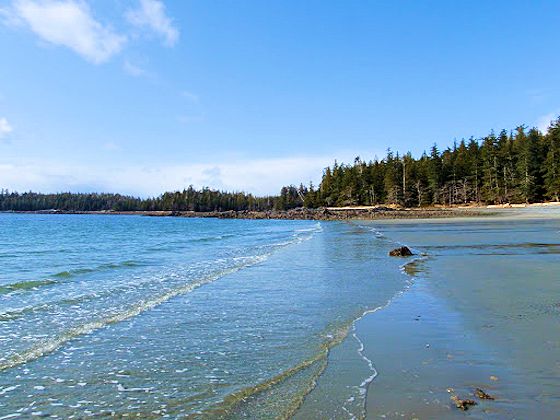
Metlakatla is located on Annette Island in the Alexander Archipelago in Southeast Alaska.
The abbreviated meaning of Metlakatla, in Shim-all-giack (the language of the Tsimshian), is “salt water passage.” Metlakatla is located on Annette Island, 15 miles southwest of Ketchikan, Alaska.
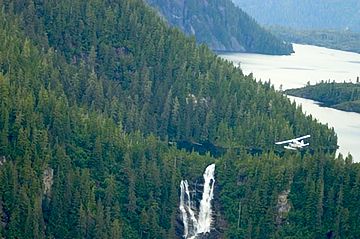 It is near the southern end of the Alexander Archipelago, a chain of hundreds of rugged, glacially carved islands interwoven with deep fjords and protected passages. It is located approximately midway in the Inside Passage between Seattle, Washington, about 600 miles to the south, and Skagway, Alaska, 600 miles to the north.
It is near the southern end of the Alexander Archipelago, a chain of hundreds of rugged, glacially carved islands interwoven with deep fjords and protected passages. It is located approximately midway in the Inside Passage between Seattle, Washington, about 600 miles to the south, and Skagway, Alaska, 600 miles to the north.
VILLAGE HISTORY
Metlakatla was formed by a Tsimshian Native Band who followed a missionary of the Anglican Church of England, Mr. William Duncan to a new home in the United States from their previous home in British Columbia, Canada.
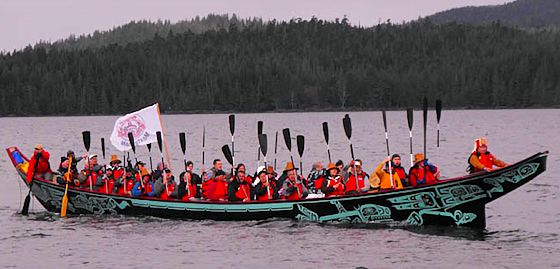
In 1887 a group of 826 Tsimshian people traveled in ocean-going canoes to their new home in Alaska.
The United States Congress granted recognition to the new community in 1891 by creating the Annette Islands Reserve, a federal Indian reservation. Today it is the only Indian reservation in the State of Alaska.
August 7 is celebrated every year as “Founders’ Day,” a day to remember the courage and foresight of the original pioneers who made this new land their home.
THE PEOPLE
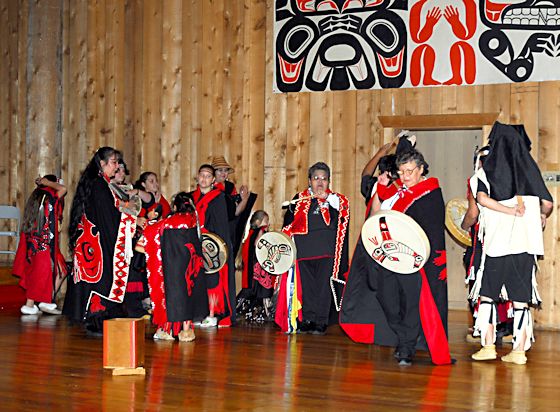
At the 2000 census, the population of Metlakla was 1,375. Although the majority of its population is Tsimshian, Metlakatla is also home to many individuals with diverse tribal affiliations such as Tlingit, Haida, Aleut, Yupik and other Alaska Native peoples.
These others are allowed to become members of the Metlakatla Indian Community by virtue of a clause in Metlakatla’s charter that specifically allows such membership. In the ancient Tsimshian culture there were several individual tribes, each with its own chief and governing council.
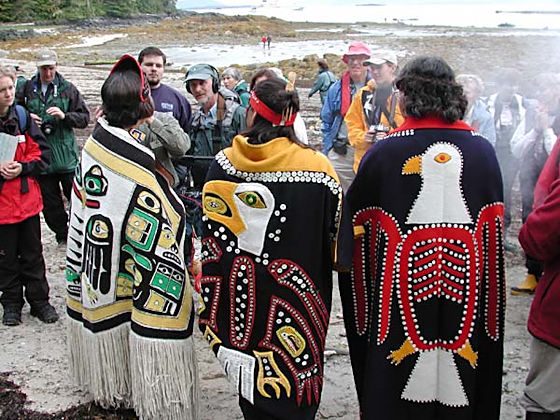
Within the tribes there exists a closer society–that of the four major clans. The clans are the Eagle, or Lachsgeek; the Raven, or Gunhada; the Wolf, or Lachgeebuu; and the Killer Whale, or Gisbuutwada. The clans hold a deep spiritual and historical meaning for the clanspeople, and their art themes can be found throughout the town of Metlakatla, and even into the beautifully decorated Metlakatla Inn & Suites.
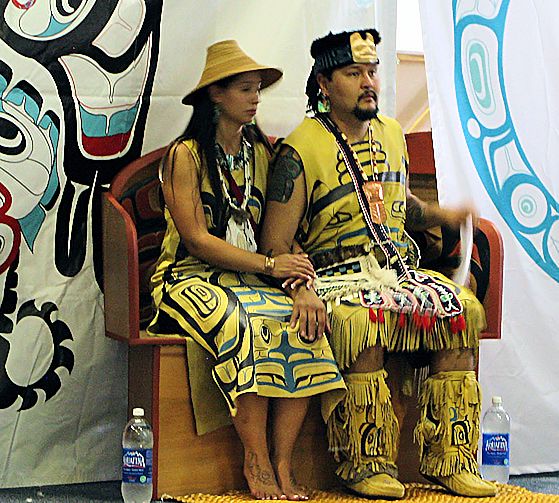
GOVERNMENT
Metlakatla is an incorporated entity officially named “Metlakatla Indian Community.” It is governed by a 12-member tribal council, mayor, secretary, and treasurer. The council and executives are responsible for the welfare of Metlakatla’s people.
TRANSPORTATION SERVICES AND FACILITIES
A large airfield was constructed on the island during WWII, so the Reservation is very accessible. After the war it became a United States Coast Guard search and rescue base. In the 1970s the new Ketchikan Airport was built at Gravina Island in the Inside Passage.
There are three small plane services running regular routes into Metlakatla. There is a ferry that runs five days a week to and from Metlakatla and Kechikan on the Alaska Marine Highway, and there is a road across the island. Cars, trucks, and a few scooters can be rented in Metlakatla.
The Metlakatla Inn has hotel rooms and suites, and a full service restaurant that is open for breakfast, lunch, and dinner. There are also two Bed and Breakfast in the area.
You can take scheduled tours on a community bus that culminate in a demonstration of Tsimshian singing and dancing in full regalia, or take an individual historical narrated guided tour with a member of the Metlakatla Indian Community. Both of these tours are open year round. There is also a gift shop where you can buy authentic Tsimshian art and local souvenirs.
CLIMATE
Metlakatla has a Marine west coast climate, with windy and wet weather year-round, cool winters, and mild summers. It snows most days during the winter, with an average seasonal total snowfall of 33.5 inches (85 cm) occurring mostly from November to March, with some accumulation during April and falls in May and October relatively rare.
Warm spells raise the high to 50 °F (10 °C) for several days each month. During summer, there is an average of 17 days with 70 °F (21 °C)+ highs, and rain still falls on around half of the days. Precipitation averages more than 101 inches (2.57 m) annually, with June and July being the driest months and October and November the wettest.
EMPLOYMENT/ECONOMY
Huge sockeye salmon are a mainstay of the local subsistence harvests. Annette Island Packing offers a wide variety of specialty Alaskan seafood, and the tribe also has a water bottling company and a rock crushing operation.
Income / Poverty Level
In 2002, the median income for a household in the Arnette Island Reserve was $43,516, and the median income for a family was $49,671. Males had a median income of $36,696 versus $22,292 for females. The per capita income was $16,140. About 7.7% of families and 8.0% of the population were below the poverty line.
Housing:
Clans / Societies:
In the ancient Tsimshian culture there were several individual tribes, each with its own chief and governing council. Within the tribes there exists a closer society–that of the four major clans. The clans are the Eagle, or Lachsgeek; the Raven, or Gunhada; the Wolf, or Lachgeebuu; and the Killer Whale, or Gisbuutwada.
Tribal Flag:
Tribal Emblem:
Legends / Oral Stories:
Famous Tsimshian:
In the News:
Further Reading:
